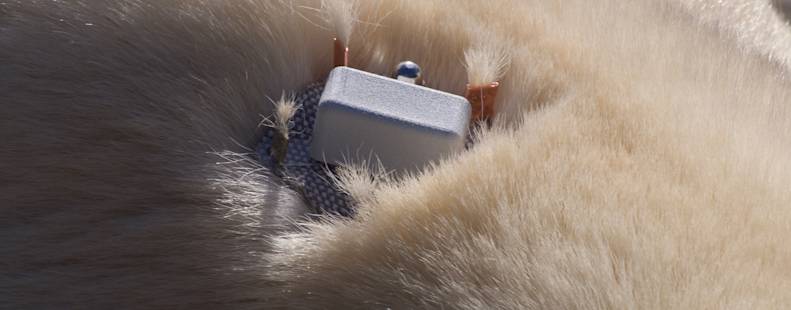Join us on our journey.
Become part of a community committed to protecting polar bears with our free newsletter.

Photo: Emily Ringer / Polar Bears International
Arctic fieldwork is incredibly challenging, but our team is known for adapting emerging technology to polar bear research and conservation.
How do researchers study polar bears on the sea ice? Or figure out how to find dens under the snow?
Field methods have come a long way from the early days, when scientists would camp in tents in the numbing cold, studying the bears through binoculars. With the advent of GPS collars and other new technology, biologists have made enormous strides—but many questions and challenges remain.
Thanks to a curious, tech-savvy staff and a range of creative partners, our team has earned a reputation for innovative research methods. These novel approaches not only benefit polar bears, but have implications for other wildlife species.
Following are some of our recent tech advances, including some still in the testing phase.
Our team is researching whether synthetic aperture radar, attached to an aircraft, can be used to find polar bear dens hidden under the snow. Current den-detection technology misses more than half of known dens, putting moms and cubs at great risk. Being able to detect and map polar bear dens is especially crucial in areas where human activity is heavy and increasing, such as Alaska’s North Slope.
Early pilot tests of this technology conducted with polar bear dens in Alaska and artificial dens in Utah yielded promising results. We plan to further refine the use of this technology by testing it on known den sites in Svalbard.
Project partners include Brigham Young University, Artemis Inc., Norwegian Polar Institute, and Simon Fraser University.
As part of our ongoing efforts to help people and polar bears coexist, we tested several different radar systems to see if they could detect approaching polar bears, triggering a warning and thus preventing needless injuries or deaths. After several years, we narrowed our selection to Spotter Global and are currently training the AI to recognize polar bears.
This work is important because melting sea ice is causing more polar bears to come ashore in more places, and for longer periods, leading to an uptick in encounters with people.
Project partners include the Town of Churchill, Spotter Global, Ohio State University, Brigham Young University, Utah’s Hogle Zoo, Assiniboine Park Zoo, and San Diego Zoo Wildlife Alliance.
3M scientists worked with us to find a better way to temporarily attach a small tracking device to a polar bear’s fur. The goal was to provide a minimally invasive way of studying the movement patterns and other activities of polar bears in the wild, giving us insights into their needs, health, and status. Another benefit of the new tags is that they will allow scientists to study two important age/sex groups—adult male polar bears and young polar bears—that can’t be tracked with traditional collars.
We tested three prototype devices on both wild and zoo bears to see if they could withstand sub-zero temperatures, snow, saltwater, and other challenges. A recent paper published on the Burr on Fur tags shows that one design in particular shows real promise as a tracking option, a finding that will help researchers as they seek to gather as much information as possible about a species that is extremely difficult to observe at length in the wild.
Project partners included 3M, Manitoba Conservation and Climate, University of Alberta, Ontario Ministry of Natural Resources, York University, and the following zoos: Point Defiance Zoo & Aquarium, Kansas City Zoo, Columbus Zoo and Aquarium, San Diego Zoo Wildlife Alliance, Como Park Zoo, Oregon Zoo, Lincoln Park Zoo, Louisville Zoo, Maryland Zoo in Baltimore, and Utah’s Hogle Zoo in the U.S.; Assiniboine Park Zoo, Cochrane Polar Bear Habitat, and Toronto Zoo in Canada; Skandinavisk Dyrepark in Denmark; and Vienna Zoo in Austria.


“We’ve partnered with Polar Bears International on a number of projects and have always been impressed with their embrace of technology and creative problem-solving. A recent example is the Burr on Fur study, which could provide a real breakthrough in how we track wildlife.”
— Dr. Megan Owen, Corporate Director of Wildlife Conservation Science, San Diego Zoo Wildlife Alliance.
Denning is the most vulnerable time in a polar bear’s life, with low survival rates even in the best of times. Better understanding the period when polar bear families emerge from their snow dens in spring and head to the sea ice to hunt seals will help managers set guidelines to avoid disturbing moms and cubs.
Through tech innovations including solar-powered cameras with batteries able to withstand extreme cold to simple Raspberry Pi computers and the use of AI to decode resulting footage and pinpoint bear activity, our trail cams provide a non-invasive way to study the bears during this sensitive time. Our team arrives in late winter to set up the cameras on snowy mountain slopes in Svalbard, just ahead of the emergence of moms and cubs.
Project partners include the Norwegian Polar Institute and San Diego Zoo Wildlife Alliance.

Become part of a community committed to protecting polar bears with our free newsletter.